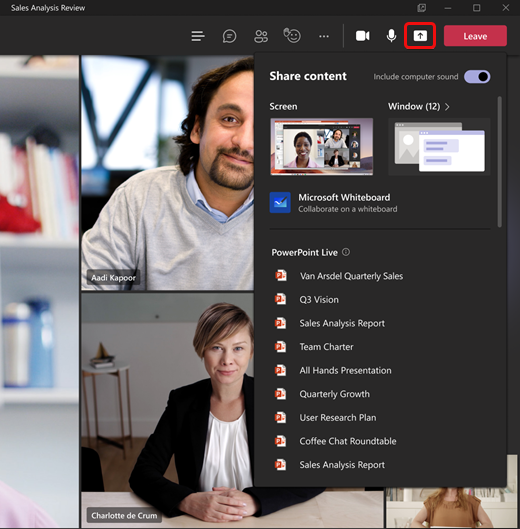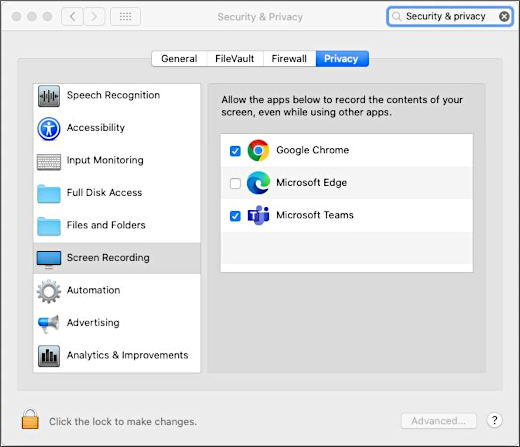To share your screen in a meeting, select Share content  in your meeting controls. Then, choose to present your entire screen; a window; a whiteboard; or a PowerPoint, Excel, or other file from your computer or OneDrive.
in your meeting controls. Then, choose to present your entire screen; a window; a whiteboard; or a PowerPoint, Excel, or other file from your computer or OneDrive.

In Teams on the web, you will see the following when you select Share content  :
:

Note: If you are using Teams on the web, you can share your screen only if you are using Google Chrome or the latest version of Microsoft Edge. Screen sharing is not available for Linux.
|
Share your...
|
If you want to...
|
Great when...
|
|
Desktop
|
Show your entire screen, including notifications and other desktop activity.
|
You need to seamlessly share multiple windows.
|
|
Window
|
Show just one window, and no notifications or other desktop activity.
|
You only need to show one thing and want to keep the rest of your screen to yourself.
|
|
PowerPoint
|
Present a PowerPoint file others can interact with.
|
You need to share a presentation and want others to be able to move through it at their own pace.
For info on PowerPoint sharing, see Share PowerPoint slides in a Teams meeting
|
|
Whiteboard
|
Collaborate with others in real time.
|
You want to sketch with others and have your notes attached to the meeting.
|
When you are finished sharing, go to your meeting controls and select Stop sharing.
Tip: If you experience choppiness or lag when you share high-motion videos, try the following keyboard shortcut after selecting Teams: Ctrl+Alt+Shift+T
Back to top
Grant permissions to share content on MacOS
If you are using a Mac, you must grant permission to Teams to record your computer's screen before you can share.
Step 1 - You will be prompted to grant permission the first time you try to share your screen. Select Open System Preferences from the prompt.
If you miss the prompt, you can do this anytime by going to Apple Menu > System Preferences> Security & Privacy.
Step 2 - Under Screen Recording, make sure Microsoft Teams is selected.

Step 3 - Go back to your meeting and try sharing your screen again.
Note: If you are using Teams on the web, make sure you have also granted screen recording permission to your web browser.
Back to top
Include computer sound
Sharing computer sound lets you stream audio from your computer to meeting participants through Teams. You can use it to play a video or audio clip as part of a presentation.
To share sound, select Share content  in your meeting controls and then Include computer sound (the switch on the top right of your sharing options). All sounds from your computer, including notifications, will be audible in the meeting.
in your meeting controls and then Include computer sound (the switch on the top right of your sharing options). All sounds from your computer, including notifications, will be audible in the meeting.

For more info, check out Microsoft Support - Share sound from your computer in Microsoft Teams meetings or live events
Back to top
Give and take control of shared content
Note: If you are using Linux, giving and taking control of shared content is not available at this time.
Give control
If you want another meeting participant to change a file, help you present, or demonstrate something, you can give control to that person. You will both be in control of the sharing, and you can take back control anytime.
Important: When you are sharing an app, only give control to people you trust. People you give control to may send commands that could affect your system or other apps. We have taken steps to prevent this, but have not tested every possible system customization.
Step 1 - On the sharing toolbar, select Give control.
Step 2 - Select the name of the person you want to give control to.
Teams sends a notification to that person to let them know you are sharing control. While you share control, the other person can make selections, edits, and other modifications to the shared screen.
Step 3 - To take control back, select Take back control.
Take control
To take control while another person is sharing, select Request control. The person sharing can then approve or deny your request.
While you have control, you can make selections, edits, and other modifications to the shared screen.
When you are finished, select Release control to stop sharing control.
Back to top
Magnify shared content
To get a better look at shared content, click and drag it to see different areas. To zoom into or out of content someone is sharing during a meeting or call, use the buttons at the lower left of your meeting window: to zoom in and to zoom out.
You can also try the following:
Note: Mac trackpads do not support zoom in meetings. If you are on a Mac, use one of the other options.
Back to top